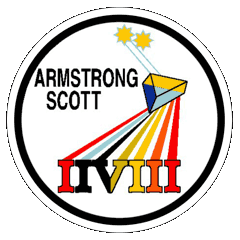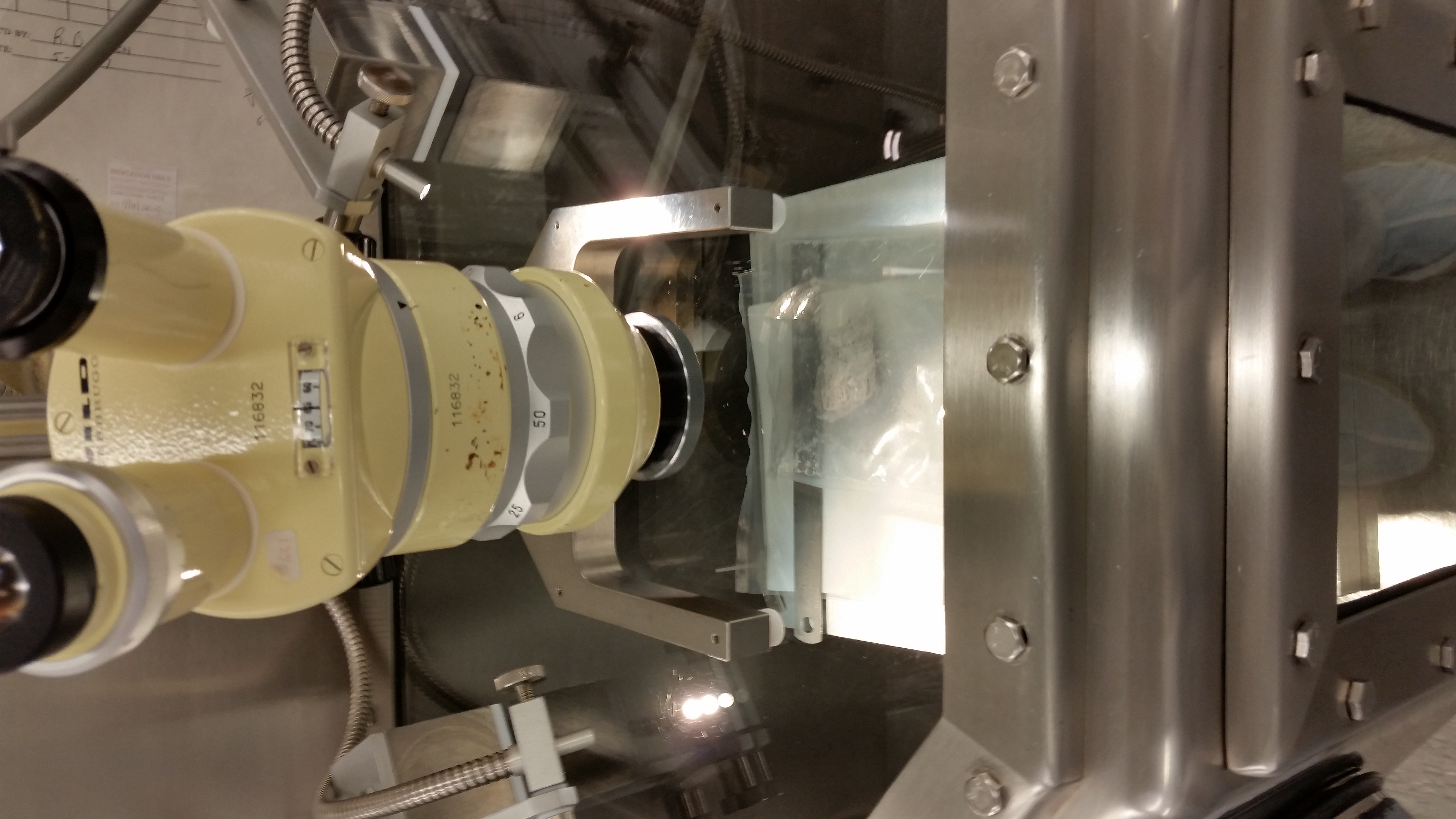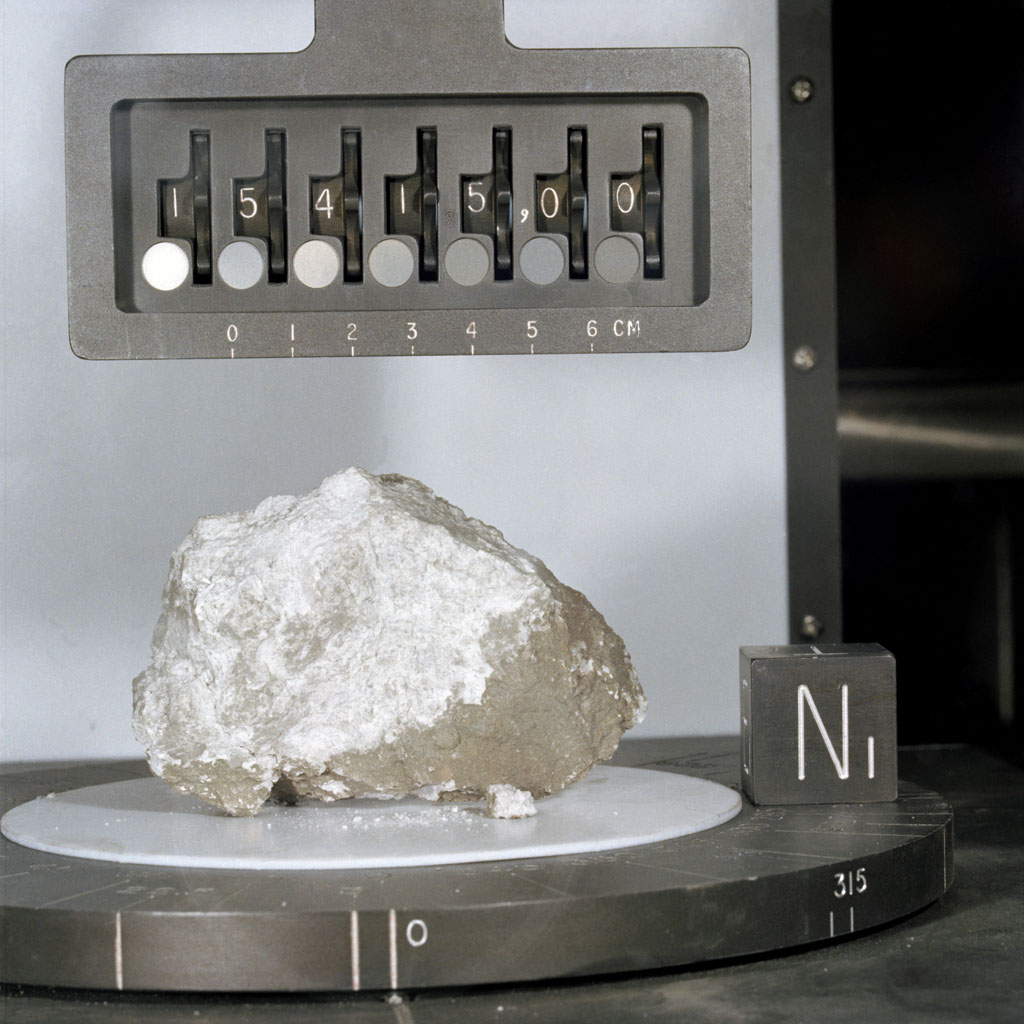|
Mons Hadley Delta
Mons Hadley Delta (δ) is a massif in the northern portion of the Montes Apenninus, a range in the northern hemisphere of the Moon adjacent to Mare Imbrium. It has a height of 3.6 km above the plains to the north and west. To the north of this mountain is a valley that served as the landing site for the Apollo 15 expedition. To the northeast of this same valley is the slightly larger Mons Hadley peak with a height of about 4.6 km. To the west of these peaks is the sinuous Rima Hadley rille. These features were named after the English mathematician and inventor of the octant John Hadley. On the Apollo 15 mission in 1971, the astronauts David Scott and James Irwin explored the lower reaches of the north slope of Mons Hadley Delta, and collected many samples which were returned to earth. Station 2 was near St. George crater, and Stations 6, 6A, and 7 were at or near Spur crater. They found the famous "Genesis Rock", sample 15415, at Spur. A clast of anorthosite with ... [...More Info...] [...Related Items...] OR: [Wikipedia] [Google] [Baidu] |
List Of Mountains On The Moon
Mountains on the Moon have heights defined relative to various vertical datums. In the 1960s, the U.S. Army Mapping Service used elevation relative to 1,737,988 meters from the center of the Moon. In the 1970s, the U.S. Defense Mapping Agency used 1,730,000 meters. The '' Clementine'' topographic data published in the 1990s uses 1,737,400 meters. This table is not comprehensive, and does not list the highest places on the Moon. ''Clementine'' data show a range of about 18,100 meters from lowest to highest point on the Moon. The highest point, located on the far side of the Moon, is approximately 6,500 meters higher than Mons Huygens (usually listed as the tallest mountain). Mountains These are isolated mountains or massifs. Mountain ranges See also *List of mountains on the Moon by height *List of features on the Moon *List of craters on the Moon * List of maria on the Moon *List of valleys on the Moon *List of mountain ranges *List of tallest mountains in the Solar Syste ... [...More Info...] [...Related Items...] OR: [Wikipedia] [Google] [Baidu] |
David Scott
David Randolph Scott (born June 6, 1932) is an American retired test pilot and NASA astronaut who was the seventh person to walk on the Moon. Selected as part of the third group of astronauts in 1963, Scott flew to space three times and commanded Apollo 15, the fourth lunar landing; he is one of four surviving Moon walkers and the last surviving crew member of Apollo15. Before becoming an astronaut, Scott graduated from the United States Military Academy at West Point and joined the Air Force. After serving as a fighter pilot in Europe, he graduated from the Air Force Experimental Test Pilot School (Class 62C) and the Aerospace Research Pilot School (Class IV). Scott retired from the Air Force in 1975 with the rank of colonel, and more than 5,600 hours of logged flying time. As an astronaut, Scott made his first flight into space as a pilot of the Gemini 8 mission, along with Neil Armstrong, in March 1966, spending just under eleven hours in low Earth orbit. H ... [...More Info...] [...Related Items...] OR: [Wikipedia] [Google] [Baidu] |
Jonathan's Space Report
''Jonathan's Space Report'' (JSR) is a newsletter about the Space Age, hosted at Jonathan's Space Page. It is written by Jonathan McDowell, a Center for Astrophysics Harvard & Smithsonian astrophysicist. It is updated as McDowell's schedule permits, but he tries to publish two issues each month. Originally the website was hosted on a Harvard University account, but was moved in late 2003 to a dedicated domain. Started in 1989, the newsletter reports on recent space launches, International Space Station activities and space craft developments. McDowell's report occasionally corrects NASA's official web sites, or provides additional data on classified launches that aren't available elsewhere. Associated projects on the JSR web site are: * A catalog of all known geosynchronous satellites and their current positions * A listing of satellite launch attempts * A cross-reference between catalog number and international designation of artificial satellites McDowell has long campaigne ... [...More Info...] [...Related Items...] OR: [Wikipedia] [Google] [Baidu] |
Cambridge University Press
Cambridge University Press is the university press of the University of Cambridge. Granted letters patent by Henry VIII of England, King Henry VIII in 1534, it is the oldest university press A university press is an academic publishing house specializing in monographs and scholarly journals. Most are nonprofit organizations and an integral component of a large research university. They publish work that has been reviewed by schola ... in the world. It is also the King's Printer. Cambridge University Press is a department of the University of Cambridge and is both an academic and educational publisher. It became part of Cambridge University Press & Assessment, following a merger with Cambridge Assessment in 2021. With a global sales presence, publishing hubs, and offices in more than 40 Country, countries, it publishes over 50,000 titles by authors from over 100 countries. Its publishing includes more than 380 academic journals, monographs, reference works, school and uni ... [...More Info...] [...Related Items...] OR: [Wikipedia] [Google] [Baidu] |
NASA
The National Aeronautics and Space Administration (NASA ) is an independent agency of the US federal government responsible for the civil space program, aeronautics research, and space research. NASA was established in 1958, succeeding the National Advisory Committee for Aeronautics (NACA), to give the U.S. space development effort a distinctly civilian orientation, emphasizing peaceful applications in space science. NASA has since led most American space exploration, including Project Mercury, Project Gemini, the 1968-1972 Apollo Moon landing missions, the Skylab space station, and the Space Shuttle. NASA supports the International Space Station and oversees the development of the Orion spacecraft and the Space Launch System for the crewed lunar Artemis program, Commercial Crew spacecraft, and the planned Lunar Gateway space station. The agency is also responsible for the Launch Services Program, which provides oversight of launch operations and countdown management f ... [...More Info...] [...Related Items...] OR: [Wikipedia] [Google] [Baidu] |
List Of Mountains On The Moon By Height
The is a list of mountains on the Moon, arranged by relative height in kilometres. More than four kilometres *Mons Huygens - 5.5 km *Mons Hadley - 4.5 km * Mons Bradley - 4.3 km 3-4 kilometres *Mons Penck - 4.0 km *Mons Hadley Delta - 3.9 km *Mons Blanc - 3.8 km *Mons Wolff - 3.8 km * Mons Ampère - 3.3 km 2-3 kilometres *Mons Pico - 2.4 km *Mons Piton - 2.1 km *Mons Vitruvius - 2.3 km 1-2 kilometres * Mons La Hire - 1.5 km *Mons Vinogradov - 1.4 km *Mons Maraldi - 1.3 km *Mons Rümker - 1.1 km Less than one kilometre *Mons Gruithuisen Gamma - 0.9 km See also {{Portal, Solar System * List of mountains on the Moon * Boot Hill * Duke Island * List of tallest mountains in the Solar System Notes Moon, by height Mountains A mountain is an elevated portion of the Earth's crust, generally with steep sides that show significant exposed bedrock. Although definitions vary, a mountain may d ... [...More Info...] [...Related Items...] OR: [Wikipedia] [Google] [Baidu] |
Anorthosite
Anorthosite () is a phaneritic, intrusive igneous rock characterized by its composition: mostly plagioclase feldspar (90–100%), with a minimal mafic component (0–10%). Pyroxene, ilmenite, magnetite, and olivine are the mafic minerals most commonly present. Anorthosites are of enormous geologic interest, because it is still not fully understood how they form. Most models involve separating plagioclase crystals based on their density. Plagioclase crystals are usually less dense than magma; so, as plagioclase crystallizes in a magma chamber, the plagioclase crystals float to the top, concentrating there. Anorthosite on Earth can be divided into five types: # Archean-age anorthosites # Proterozoic anorthosite (also known as massif or massif-type anorthosite) – the most abundant type of anorthosite on Earth # Layers within Layered Intrusions (e.g., Bushveld and Stillwater intrusions) # Mid-ocean ridge and transform fault anorthosites # Anorthosite xenoliths in other rocks ... [...More Info...] [...Related Items...] OR: [Wikipedia] [Google] [Baidu] |
Genesis Rock
The Genesis Rock (sample 15415) is a sample of Moon rock retrieved by Apollo 15 astronauts James Irwin and David Scott in 1971 during the second lunar EVA, at Spur crater. With a mass of , it is currently stored at the Lunar Sample Laboratory Facility in Houston, Texas. Rock Chemical analysis of the Genesis Rock indicated it is an anorthosite, composed mostly of a type of plagioclase feldspar known as anorthite. The rock was formed in the early stages of the Solar System, at least 4 billion years ago. It was originally thought they had found a piece of the Moon's primordial crust, but later analysis initially showed that the rock was only 4.1 ± 0.1 billion years old, which is younger than the Moon itself, and was formed after the Moon's crust solidified. It is still an extremely old sample, formed during the Pre-Nectarian period of the Moon's history. Dating of pyroxenes from other lunar anorthosite samples gave a samarium–neodymium age of crystallization of 4.46 b ... [...More Info...] [...Related Items...] OR: [Wikipedia] [Google] [Baidu] |
Spur (lunar Crater)
Spur is a feature on Earth's Moon, a crater in the Hadley–Apennine region. Astronauts David Scott and James Irwin visited it in 1971, on the Apollo 15 mission, during EVA 2. Spur was designated Geology Station 7. Spur is located on the north slope of Mons Hadley Delta, about 200 m above the plain to the north. It is east of the much larger St. George crater, and about 5 km south of the Apollo 15 landing site itself. The astronauts found the "Genesis Rock", sample 15415, at Spur. The sample contains a large clast of anorthosite, and Dave Scott said "Guess what we just found! I think we found what we came for" as he examined the sample. They also found samples 15445 and 15455, so-called black and white breccias, which are thought to be impact melt breccia resulting from the Imbrium basin impact event.To a Rocky Moon: A Geologist's History of Lunar Exploration. Don E. Wilhelms, University of Arizona Press (1993), p. 276. The crater was named by the astronauts, and ... [...More Info...] [...Related Items...] OR: [Wikipedia] [Google] [Baidu] |
James Irwin
James Benson Irwin (March 17, 1930 – August 8, 1991) was an American astronaut, aeronautical engineer, test pilot, and a United States Air Force pilot. He served as Apollo Lunar Module pilot for Apollo 15, the fourth human lunar landing. He was the eighth person to walk on the Moon and the first, and youngest, of those astronauts to die. Early life and education Irwin was born March 17, 1930, in Pittsburgh, Pennsylvania, of Scottish and Irish descent, to parents James William Irwin (1896–1979), a U.S. Army World War I veteran, and Elsa Mathilda Irwin (; 1899–1993). Irwin's grandparents emigrated to the U.S. from Altmore Parish at Pomeroy in County Tyrone, Ireland (now Northern Ireland) around 1859. At about the age of 12, he informed his mother about his desire to go to the Moon, letting her know that he might be the first person to do so (he ended up being the eighth). He graduated from East High School in Salt Lake City, Utah in 1947. He received a Bachelor of ... [...More Info...] [...Related Items...] OR: [Wikipedia] [Google] [Baidu] |
John Hadley
John Hadley (16 April 1682 – 14 February 1744) was an English mathematician, and laid claim to the invention of the octant, two years after Thomas Godfrey claimed the same. Biography He was born in Bloomsbury, London the eldest son of George Hadley of Osidge, East Barnet, Hertfordshire and his wife Katherine FitzJames. His younger brother George Hadley became a noted meteorologist. In 1717 John became a member (and later vice-president) of the Royal Society of London. In 1729 he inherited his father's East Barnet estate. He died in East Barnet in 1744 and is buried in the local churchyard with other members of his family. He had married Elizabeth, daughter of Thomas Hodges, FRS (former Attorney General of Barbados) and had one child, a son and heir John, born in 1738. Work In 1730 Hadley invented the reflecting octant, which could be used to measure the altitude of the sun or other celestial objects above the horizon at sea. A mobile arm carrying a mirror and pivotin ... [...More Info...] [...Related Items...] OR: [Wikipedia] [Google] [Baidu] |
Moon
The Moon is Earth's only natural satellite. It is the fifth largest satellite in the Solar System and the largest and most massive relative to its parent planet, with a diameter about one-quarter that of Earth (comparable to the width of Australia). The Moon is a planetary-mass object with a differentiated rocky body, making it a satellite planet under the geophysical definitions of the term and larger than all known dwarf planets of the Solar System. It lacks any significant atmosphere, hydrosphere, or magnetic field. Its surface gravity is about one-sixth of Earth's at , with Jupiter's moon Io being the only satellite in the Solar System known to have a higher surface gravity and density. The Moon orbits Earth at an average distance of , or about 30 times Earth's diameter. Its gravitational influence is the main driver of Earth's tides and very slowly lengthens Earth's day. The Moon's orbit around Earth has a sidereal period of 27.3 days. During each synodic period ... [...More Info...] [...Related Items...] OR: [Wikipedia] [Google] [Baidu] |



_Labrador.jpg)


